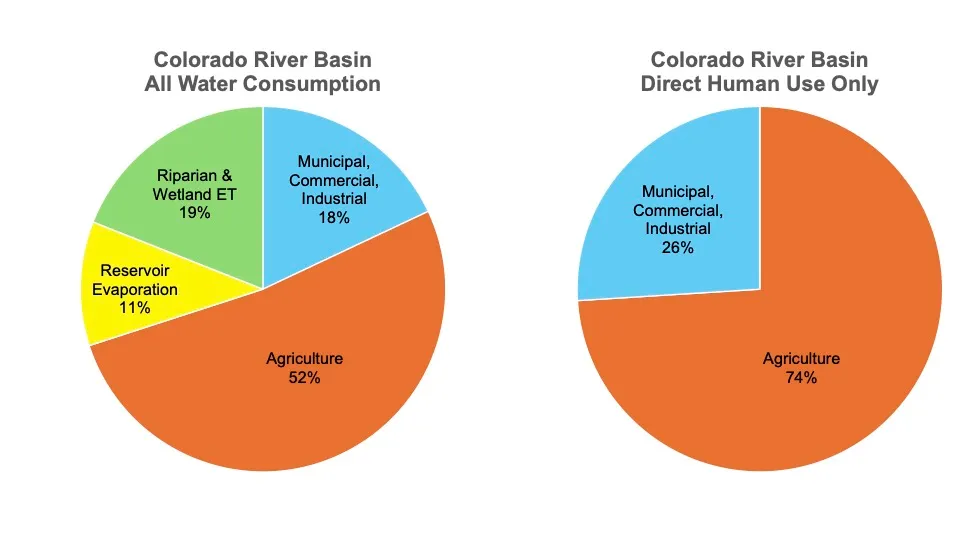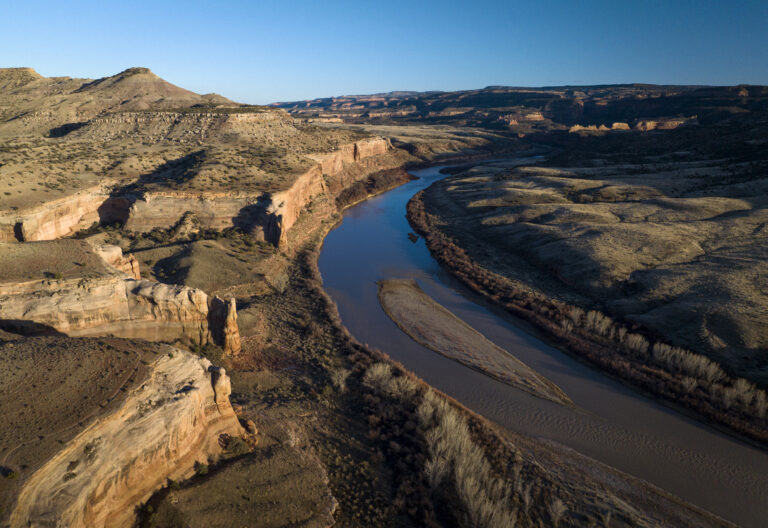The Colorado River passes through Mesa County, March 7, 2024, near Loma. New research illuminates how water is used in the drought-stressed river basin. (Hugh Carey, The Colorado Sun)
The Colorado River has been overused for decades, but no one has known exactly how the water was used — until a team of researchers compiled the most complete accounting of the river’s water
Next time you take a bite out of a juicy hamburger or chunk of cheese made in the western U.S., say thank you to the Colorado River.
Researchers released the most complete accounting so far of how the river’s water is used. They found that alfalfa — used as feed for beef and dairy cows — sucks up more water than all the cities and industries in the enormous Colorado River Basin.
The researchers incorporated new factors, like water used by nature, Mexico and out-of-basin water transfers, that haven’t been counted before. And with those numbers, the researchers made it clear that water use in the basin needs to drop by 22% to 29% to stabilize historically low reservoirs.
The research, published March 28, comes just in time: Seven state negotiators, 30 tribal nations and federal officials are all weighing how the river’s water will be managed for decades to come.
“Because of these intense negotiations going on over the future management of the Colorado River, we were quite anxious to get the most accurate numbers in front of those negotiators,” said Brian Richter, the study’s lead author and president of Sustainable Waters, a global organization focused on water scarcity challenges.

The U.S. Bureau of Reclamation, which owns and operates massive infrastructure in the Colorado River Basin, is the primary accountant of the river’s water. But past efforts to show how that water is used haven’t taken key factors into account, according to the study, published in the academic journal Communications Earth & Environment.
Reclamation incorporated water sucked up by plants and lost to the atmosphere, but only in riverfront ecosystems in the lower Colorado River. A 2012 report did not include the Gila River basin, which provides most of the water for the Phoenix area.
Other studies haven’t included water use in Mexico, tied to evaporation from reservoirs, or from transfers out of the basin to places including Denver, Fort Collins and Colorado Springs. Even a 2020 study led by Richter did not include all the relevant uses — and that has created uncertainty all around, Richter said.
The oft-cited study estimated that agriculture represented nearly 80% of the water used in the basin, but that study did not include usage by Mexico, the environment, exports out of the basin or through reservoir evaporation. When those uses are taken into account, agriculture represents half the overall use.
“We thought that it was about time for somebody to do an accounting for where all of the water goes,” Richter said. “We really wanted to bring nature into that conversation.”
A new, improved water budget
Richter worked with 11 other researchers from universities around the country to compile what they say is the first complete accounting of water use in the Colorado River Basin.
Their research shows that the Colorado River was overused in 16 of the 21 years during the research period, 2000-2020. Water users overdrafted by 10% on average, driving down the basin’s biggest reservoirs, lakes Mead and Powell, which act like enormous water savings banks.
It may not be a surprise that irrigated agriculture uses the most water, taking up 52% of the water consumed across the 246,000-square-mile basin. But a shocking one-half of that is from just one crop used to feed livestock rather than humans: alfalfa.
Across the basin, alfalfa hay uses more than 5 million acre-feet of Colorado River water — that’s 26% of all the water consumed in the basin. One acre-foot roughly equals the annual water use of two or three households.
In the Upper Basin, irrigated agriculture consumes 2.8 million acre-feet, or nearly half the water used by Colorado, New Mexico, Utah, Wyoming, the environment, reservoirs and water exports out of the basin. Cattle-feed crops, like alfalfa, consume 90% of all water used by Upper Basin agriculture.
That means alfalfa uses more water than cities […]
Full article: coloradosun.com

